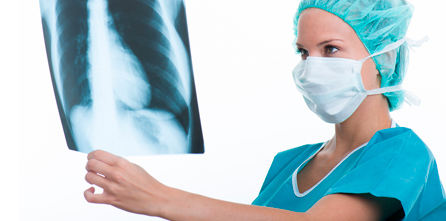
Pneumonia is an inflammation of the pulmonary parenchyma (lung tissue) caused by an infection. When it affects the general population it is called community-acquired pneumonia (CAP) to distinguish it from hospital-acquired pneumonia (HAP) or nosocomial pneumonia, which is due to a different causative agent and has a generally poorer prognosis.
COMMUNITY-ACQUIRED PNEUMONIA (CAP)
Community-acquired pneumonia (CAP) is not a single process but rather a group of infections caused by different micro-organisms and affecting different types of people, thereby determining epidemiology, physiopathology, clinical symptoms and specific prognosis.
The actual figures for CAP are difficult to establish because a large number of cases are never accurately diagnosed. The annual rate in adults varies from 1.6 to 13.4 cases for every 1,000 inhabitants, with significantly higher rates in the very young, the very old and males.
CAP is the infection that more often results in patients being admitted to hospital and is the most frequent cause of death from infection.
More than a hundred micro-organisms can cause a respiratory infection, although if a CAP is suspected, the pneumococcus bacterium is the most likely cause, along with the local epidemiological situation.
Micro-organisms can invade the surface of the respiratory epithelium in a number of ways, by direct spread, via the blood, by being inhaled and by bacterial colonisation of the mucous membranes. Inhalation is the most frequent way in which viruses, atypical organisms, fungi and micro-bacteria enter the respiratory tract. But the usual mechanism by which pneumonia occurs is by prior colonisation of the upper respiratory tract and subsequent aspiration of contaminated secretions. The mouth and pharyngeal flora of normal healthy individuals is a complex mix of many species of aerobic and anaerobic micro-organisms that remains fairly stable most of the time.
Once potentially pathogenic micro-organisms have colonised the upper respiratory tract, aspiration of even small quantities of these secretions is the most common way of inoculating the lower respiratory tract.
Pneumonia sufferers typically have a fever, they will generally feel unwell and display any combination of respiratory tract symptoms, such as a cough (90%), expectoration (66%), shortness of breath – dyspnoea – (66%), chest pain (50%) and haemoptysis – expectoration of blood or blood-stained sputum (15%). Breathing becomes faster, heart rate and pulse increase and the body’s temperature rises.
Giving up smoking and excessive alcohol intake, as well as monitoring any underlying chronic diseases are all important factors in preventing pneumonia.
Pneumococcal vaccine contains the serotypes responsible for 98% of bacterial pneumonias.
All people over the age of 65 should be vaccinated, along with people whose immune systems are compromised in some way, making them more susceptible to pneumococcal diseases or the complications linked to them. It is advisable to re-administer the vaccine every 6 years.
The flu vaccine can prevent pneumonia, both in its viral and secondary bacterial form, in certain patients. It should be administered every year in the autumn to people at risk of suffering complications from flu and to those who are in danger of transmitting the infection to high risk individuals.
HOSPITAL-ACQUIRED PNEUMONIA (HAP)
Hospital-acquired pneumonia (HAP) or nosocomial pneumonia can be defined as an infection of the pulmonary parenchyma occurring at least 48-72 hours after a patient has been admitted to hospital.
As its development and the micro-organisms that cause it are both different to those that cause community-acquired pneumonia, HAPs form a separate subgroup of respiratory tract infections. The rate is from 4 to 7 cases for every 1,000 hospital admissions and in patients needing prolonged orotracheal intubation, the rate rises by 25%.
The most frequent cause is micro aspiration of oropharyngeal and/ or gastric content colonised by bacteria. Other causal mechanisms may include direct inoculation of micro-organisms in the respiratory tract by contaminated aerosols or by spreading via blood from septic sites elsewhere in the body
The clinical symptoms are similar to other forms of pneumonia, but with some distinctive features.
HAP has a very high death rate, varying between 25% and 50%. Mortality is higher if the pneumonia has been acquired during mechanical ventilation.
The information published in this media neither substitutes nor complements in any way the direct supervision of a doctor, his diagnosis or the treatment that he may prescribe. It should also not be used for self-diagnosis.
The exclusive responsibility for the use of this service lies with the reader.
ASSSA advises you to always consult your doctor about any issue concerning your health.












